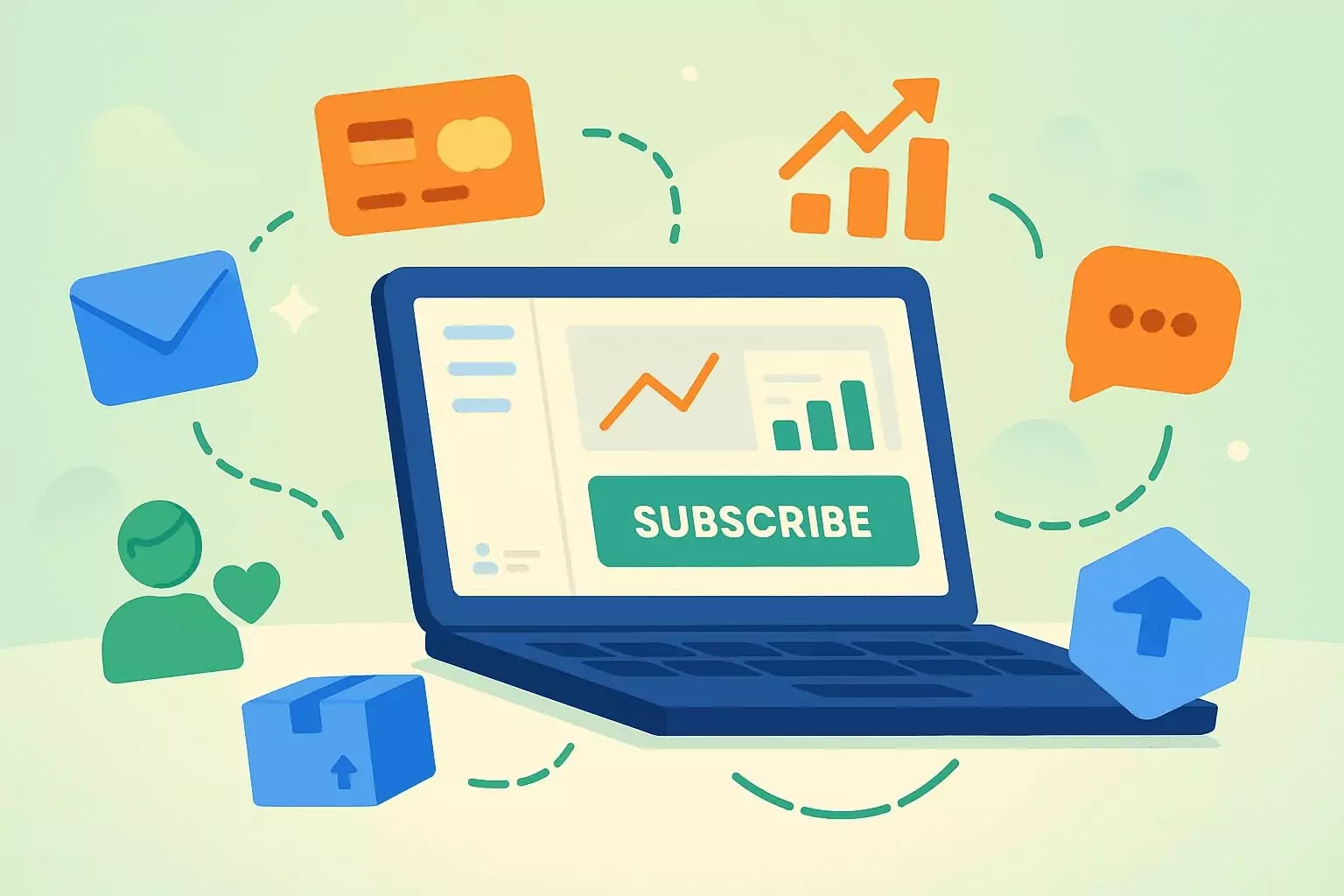1. Subscription-First D2C E-Commerce Platform
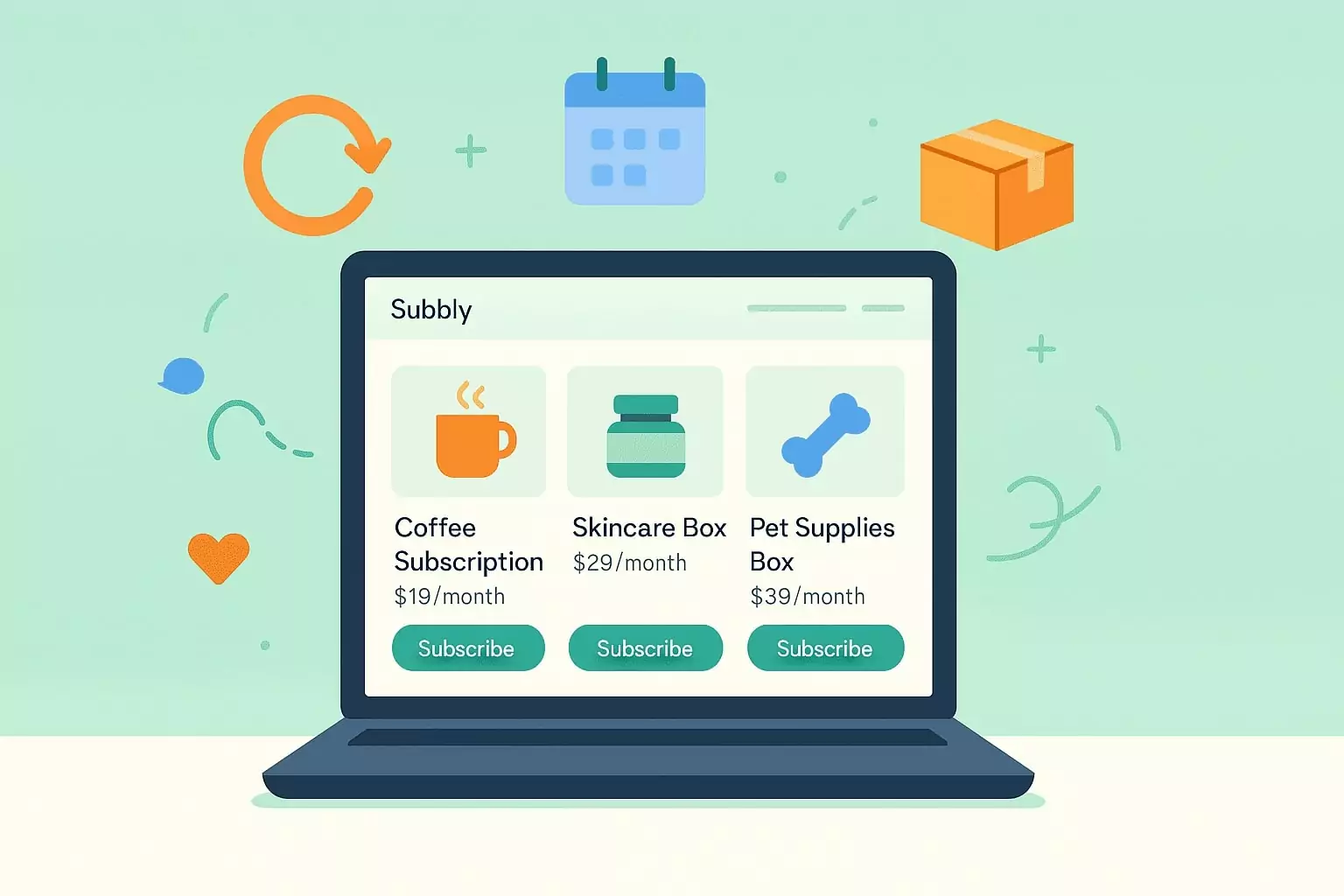
An e-commerce platform is software that allows businesses to sell products or services online, manage transactions, and process customer payments.
Traditional e-commerce platforms are designed for one-time purchases, where customers select a product, complete checkout, and receive their order.
Popular examples include:
Choosing the right D2C ecommerce platform is critical, as it will form the heart of your business.
However, if you want to sell on a subscription basis, the platforms listed above have limitations that may make scaling your business difficult.
Let’s take a look at those limitations in greater detail.
⚠️ Most ecommerce platforms don’t adequately support subscriptions
To start a subscription-based ecommerce business, you need an ecommerce platform optimized for managing recurring revenue and purchases.
The problem is, if you want to do this using popular platforms like Shopify, you need to use third-party plugins and workarounds.
There’s a whole host of reasons why this is a problem:
Poor integration
Many third-party apps do not fully integrate with the platform, leading to a disjointed purchase experience and higher cart abandonment.
Because they aren’t designed to work together, these apps can cause software conflicts, failed payments, and bugs.
Also, sometimes these apps are shut down or changes are made to their features without warning, meaning businesses face disruptive migrations or upgrades.
Payment issues
Payments are often processed outside the main platform, creating accounting and reporting issues.
Lack of functionality
Third-party apps are often limited, restricting your control over pricing models, trial periods, and discounts. Traditional ecommerce platforms also usually lack advanced tools for upsells, retention campaigns, and customer engagement.
This also impacts your customers’ control over their subscriptions. They may have to manage subscriptions through a separate portal, leading to frustration and churn.
More expensive
Third-party apps often charge additional regular fees and transaction charges. This increases your monthly expenses.
Difficulty using data effectively
Subscription and e-commerce data may be stored separately, making it harder to track key metrics.
Subscription-first D2C ecommerce platforms integrate everything needed to manage subscriptions from the start. They ensure a seamless experience for both businesses and subscribers.
Best choice for subscription ecommerce software: Subbly
Subbly is an all-in-one solution designed for DTC subscription businesses. It includes native subscription management, automated billing, customer self-service tools, and built-in analytics, all without requiring external plugins.
With customizable checkout and marketing automation, it offers a seamless foundation for launching and scaling a subscription business.
It even provides pre-built D2C-optimized website templates, like the one below for a razor blade subscription website, to help you quickly establish your business.
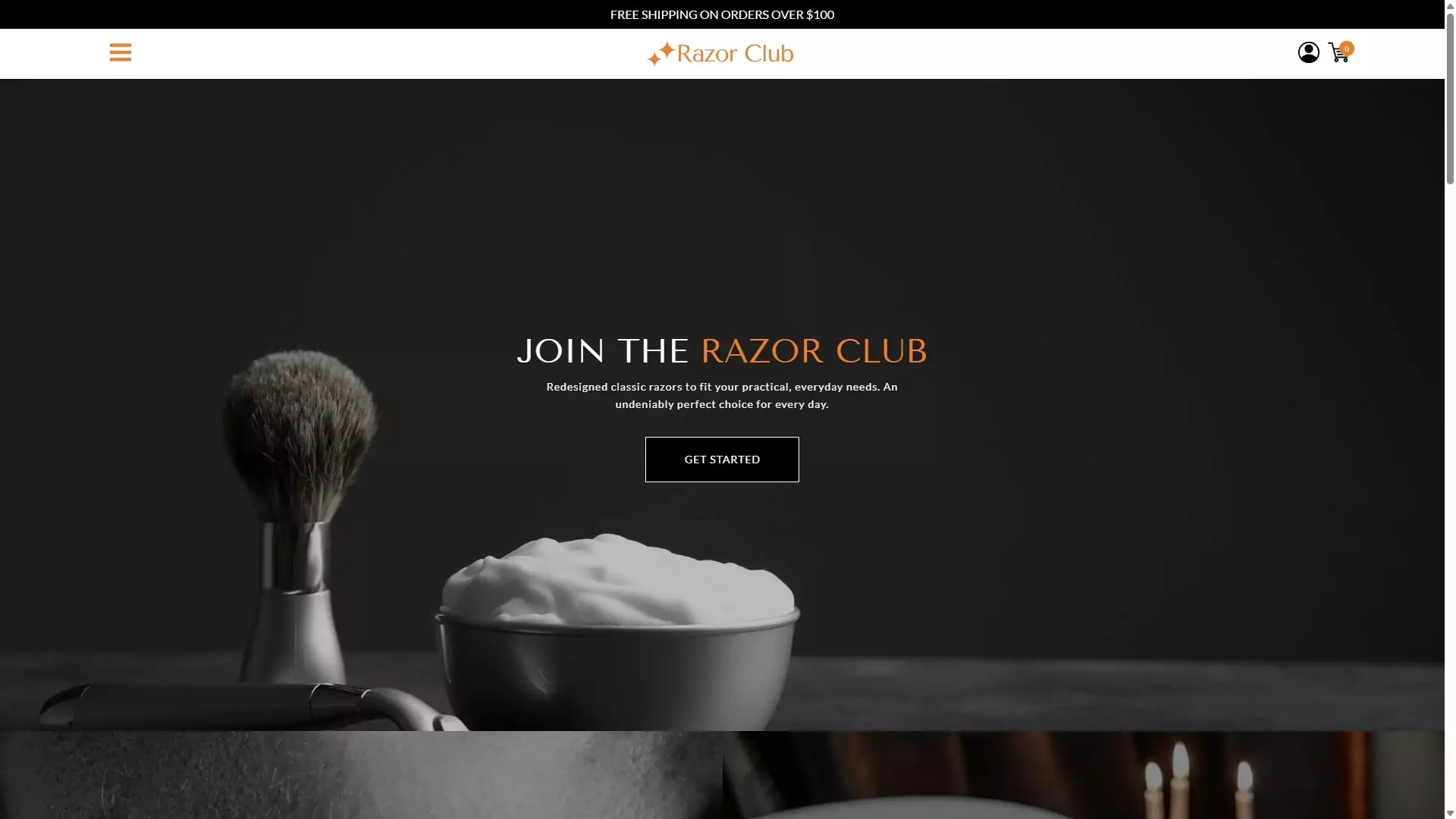
Case study: Pure Roasters CoffeePure Roasters Coffee sells ethically sourced specialty coffees. In 2019, the company wanted to add a subscription service. They were attracted to Subbly because it allowed them to use customer data to understand customer preferences and use them to improve their service. Within 3 months of using Subbly, the company had increased its monthly recurring revenue (MRR) by 30X and processed more than 1,000kg of coffee monthly.
|
Let’s compare Subbly to the other ecommerce platforms mentioned above. As you can see, Subbly is far less reliant on plugins than its competitors.
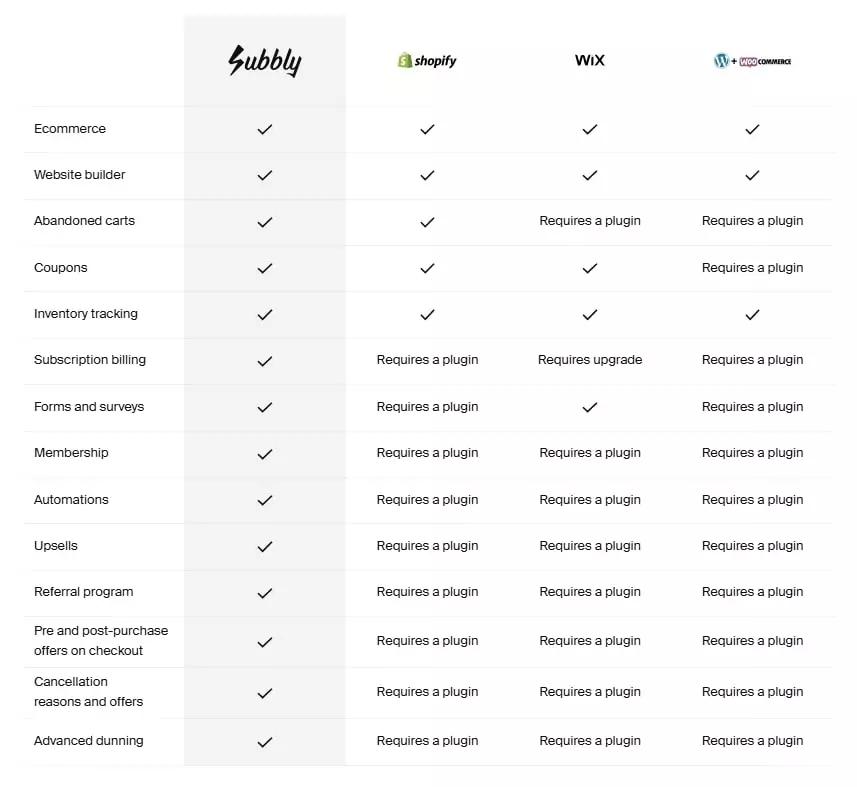
2. Payment Processing
A payment processor is the technology that handles transactions between customers and businesses. It securely authorizes payments, ensures funds are available, and transfers them.
Like with all online purchases, direct-to-consumer (DTC) subscription customers need a smooth sign-up process.
However, the recurring nature of these purchases means it’s easy to lose customers if there is a problem with a payment. So, a reliable billing system is critical for customer retention.
A Baymard Institute study found that 70% of all online shopping carts are abandoned before purchase, with poor user experience being one of the primary drivers.
Choosing the right tools reduces failed payments, increases conversions, and improves retention, all essential for a sustainable subscription business.
What to look for in payment processing software
- Recurring billing support: Handles automated payments on flexible billing cycles.
- Multiple payment methods: Accepts credit/debit cards, PayPal, and alternative payment options like BNPL.
- Dunning management: Automatically retries failed payments and notifies customers to update billing details.
- Fraud prevention and security: Ensures PCI compliance and protects against chargebacks.
- Seamless checkout integration: Works with your e-commerce platform to provide a smooth payment experience.
Best payment processing software
The right solution should support recurring billing, multiple payment methods, and fraud prevention.
We recommend Stripe to most of our customers. It supports subscriptions with flexible billing cycles and multi-currency payments. It also has lower transaction and chargeback fees than other platforms, and the user experience is generally better.
However, some other options that you may wish to consider include:
- PayPal: A widely recognized payment option that provides easy access to funds and cheaper charges on microtransactions.
- Google Pay and Apple Pay: Including these mobile payment systems makes the checkout process more convenient for customers and increases conversion rates.
Another important aspect of payment processing is the checkout system. This is the customer-facing interface where users enter their payment details, review pricing, and confirm their subscription. It manages the entire payment experience from sign-up to renewal.
Even with a great payment processor, a complicated or slow checkout experience can lead to abandoned sign-ups. A well-optimized checkout makes subscribing quick, clear, and hassle-free.
This should be built into your e-commerce platform, but if it isn’t, you may wish to get specialized checkout software. Examples include:
- Bolt: A one-click checkout tool designed to reduce friction and increase conversion rates.
- Checkout.com: A global payment and checkout solution that supports subscription businesses.
3. Order Fulfillment and Inventory Management
Struggling to keep track of stock and deliver to customers on time? Fulfillment and inventory management software ensures that subscription orders are packed, shipped, and arrive on time while monitoring inventory levels.
This is critical for DTC subscription businesses as they must deliver products regularly, often with varying product selections. If they miss a delivery or are late, they risk displeasing customers.
Some platforms combine fulfillment and inventory tracking, while others require separate tools.
What to look for in fulfillment software
- Recurring shipments: Ensures customers receive their subscription boxes or products on time each cycle.
- Stock tracking: Prevents overselling and allows businesses to forecast inventory needs.
- Automated order processing: Reduces manual work by automatically sending orders to fulfillment centers.
- Seamless returns: Helps manage exchanges and customer-initiated returns efficiently.
Without the right system, businesses risk shipping delays, inventory shortages, and poor customer experience, leading to churn.
Best fulfillment and inventory software
You can get specialized software to handle fulfillment and inventory separately. For example, Cin7 syncs inventory across multiple warehouses and sales channels, while EasyPost provides shipping APIs to connect businesses with multiple carriers.
However, managing inventory and fulfillment separately can create inefficiencies. A combined solution may be quicker, simpler, and more scalable.
Examples include:
- ShipStation: A platform that makes it easy to generate labels and to connect with multiple shipping providers.
- Flexport: A fulfillment service that specializes in fast shipping and integrates with multiple sales channels.
- Easyship: Provides multi-carrier shipping options and helps businesses manage warehouse operations.
4. Customer Support and Engagement
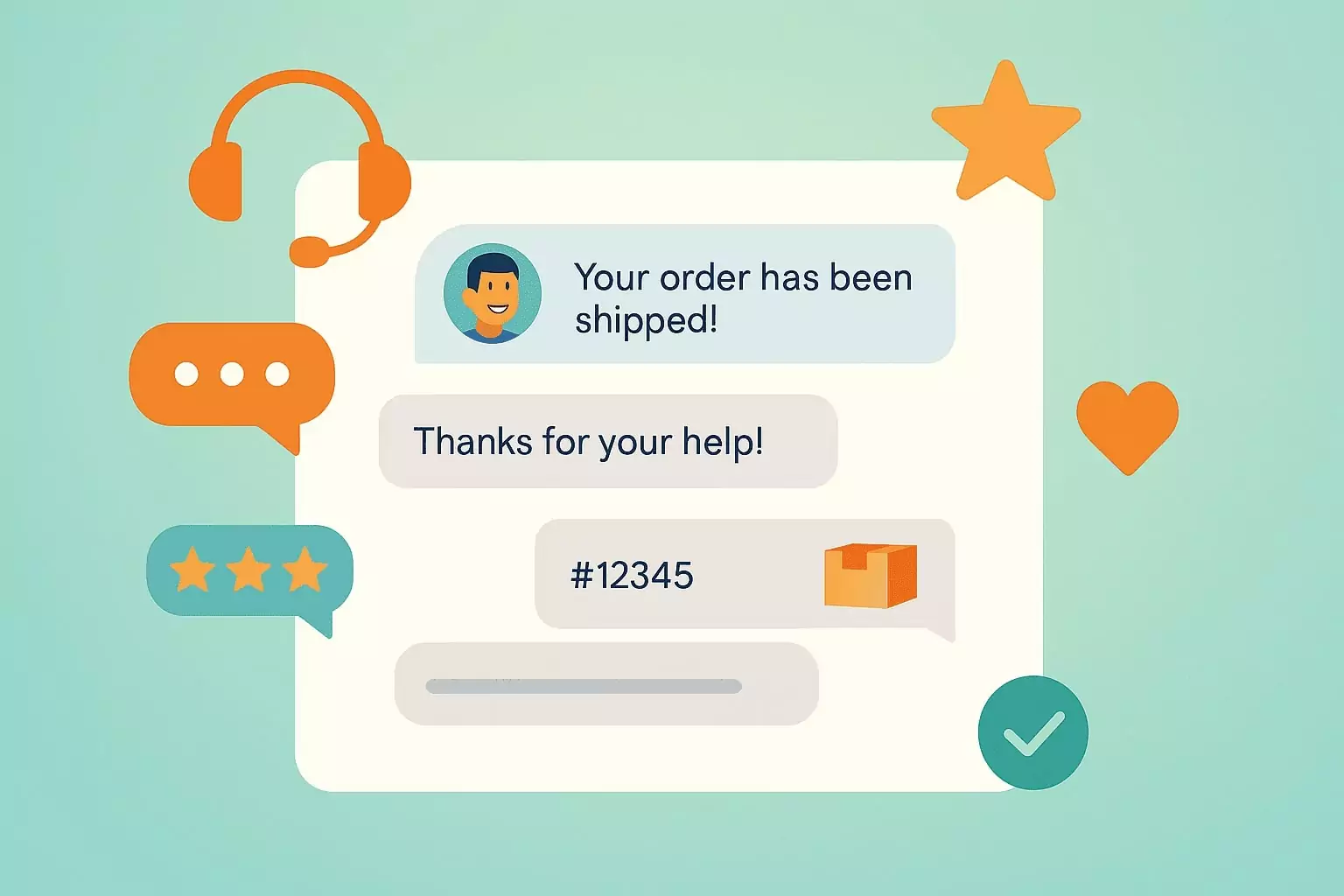
88% of customers say good customer service makes them more likely to purchase again. In other words, customer service is critical to ensure your subscribers remain loyal.
Customer support and engagement software helps DTC subscription businesses manage customer inquiries, resolve issues efficiently, and build stronger relationships with subscribers.
Poor support experiences can lead to:
- High churn rates: If customers struggle to update their payment info or manage their subscription, they may cancel.
- Increased chargebacks and disputes: Lack of clear support options can cause frustrated customers to dispute charges.
- Missed upsell opportunities: Engaged customers are more likely to upgrade, refer friends, or extend their subscriptions.
A good customer support system ensures subscribers can easily update their payment details, modify their plans, request cancellations, or get quick answers to their questions.
All of these factors directly impact customer satisfaction and long-term loyalty.
What to look for in customer support software
DTC subscription businesses should look for customer support tools that include:
- Multi-channel support: Allows businesses to manage email, live chat, and social media inquiries from one platform.
- Automated responses and workflows: Reduces manual workload by handling common subscription-related questions automatically.
- Integration with subscription and payment systems: Ensures agents can see customer subscription details, billing history, and plan changes in one dashboard.
- Self-service capabilities: Enables customers to modify their subscriptions, update billing information, or cancel without contacting support.
- Performance analytics: Provides insights into response times, resolution rates, and common customer issues to improve service quality.
Best customer support software
- Gorgias: A customer service helpdesk built for e-commerce and subscription brands, with automation features for handling common subscription-related questions.
- Zendesk: A widely used multi-channel support tool that offers ticketing, live chat, and knowledge base features.
- Tidio / Drift: Live chat and chatbot solutions that help answer customer questions in real-time.
5. CRM Software
Customer relationship management (CRM) software stores and organizes customer data, helping businesses track interactions, manage relationships, and improve retention.
It enables DTC businesses to monitor subscriber behavior, identify churn risks, and personalize customer interactions over time.
Without a CRM, businesses often store customer data in spreadsheets. This is difficult to manage and unsecure.
Worse still, it’s difficult to analyze the data, making it challenging to understand subscriber needs. This can lead to poor customer experiences, missed upsell opportunities, and higher churn rates.
A strong CRM system allows businesses to:
- Track subscriber history: See order history, plan changes, support interactions, and engagement levels in one place.
- Personalize communication: Use customer data to tailor messages, offers, and recommendations based on behavior.
- Improve retention: Identify churn risks early and proactively re-engage customers before they cancel.
- Streamline customer support: Equip support teams with customer insights to resolve issues faster.
Key features to look for in CRM software
- Unified customer profiles: Stores contact details, subscription history, support tickets, and engagement data in one place.
- Behavior tracking: Monitors subscription activity, order frequency, and engagement levels to predict churn risk.
- Automated workflows: Triggers reminders, follow-ups, and retention campaigns based on customer actions.
- Integration with subscription platforms: Syncs with billing, fulfillment, and customer support tools for a centralized view of each subscriber.
- Advanced reporting and segmentation: Provides insights into customer lifetime value (LTV), churn trends, and engagement patterns.
Best CRM software
- HubSpot: A full-featured CRM with marketing automation, customer tracking, and analytics.
- Salesforce: An enterprise-level CRM with advanced customer segmentation and workflow automation.
- ActiveCampaign: A CRM designed for automated email and customer journey tracking.
- Zoho CRM: A budget-friendly CRM with customizable pipelines and integration capabilities.
6. Marketing Software
Marketing software helps DTC subscription businesses attract new customers, increase revenue, engage existing subscribers, and reduce churn.
This covers a broad range of capabilities and tools. However, a strong direct-to-customer subscription marketing stack typically includes:
- Email and SMS marketing to engage and retain subscribers.
- Paid advertising platforms to acquire new customers.
- Referral and loyalty programs to drive organic growth.
Key features to look for in marketing software
As mentioned above, your marketing strategies should support renewals. To do this, your software should enable:
- Automation: Helps you send renewal reminders, win-back campaigns, and onboarding sequences at the right time.
- Customer segmentation: Allows you to tailor messaging based on subscription status, engagement level, and past purchases, improving conversion rates and subscriber retention.
- Performance tracking: Essential for providing insights into which marketing campaigns drive the most valuable subscribers and where adjustments are needed to improve acquisition and retention strategies.
Best marketing software
Email and SMS marketing
- Klaviyo: Advanced automation for email and SMS campaigns tailored to e-commerce and subscriptions.
- Postscript: SMS marketing designed for DTC brands, with deep Shopify and subscription integrations.
- Omnisend: Multi-channel marketing that combines email, SMS, and push notifications.
Paid advertising and customer acquisition
- Meta Ads (Facebook and Instagram): The most effective ad platform for DTC subscription growth.
- Google Ads: Covers search, display, and YouTube advertising for broader reach.
- TikTok Ads: Ideal for targeting younger audiences and promoting subscription products visually.
Referral and loyalty programs
- Yotpo: A full-suite loyalty, referral, and rewards platform with subscription-friendly features.
- ReferralCandy: A simple referral program tool designed for e-commerce and subscriptions.
- Smile.io: A points-based loyalty system that rewards subscribers for engagement and long-term subscriptions.
Start Your Subscription D2C Business with Subbly
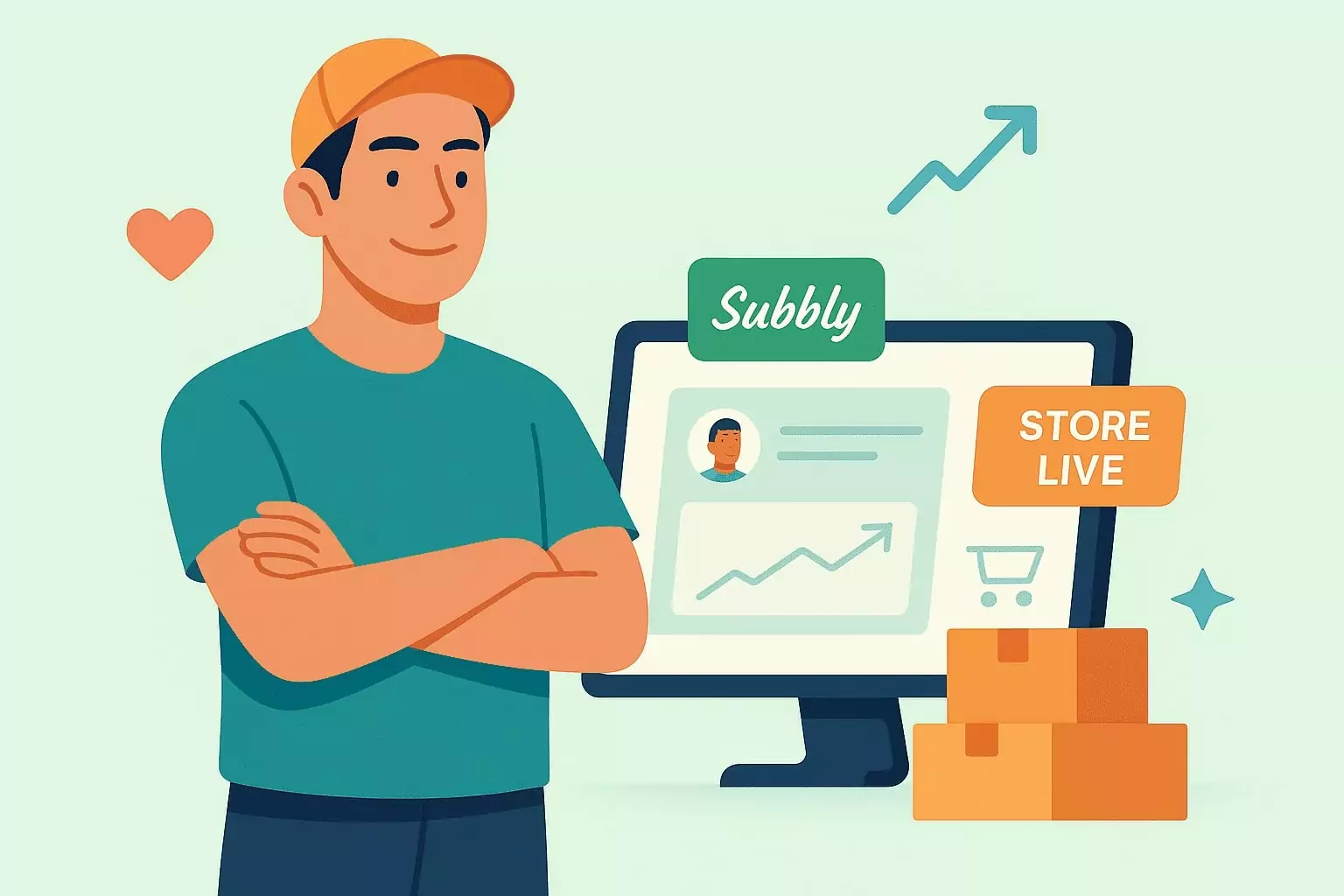
Subbly is designed specifically for subscription businesses. It includes many of the essential tools covered in this guide, including:
- A subscription-first e-commerce platform: Unlike general platforms like Shopify or WooCommerce, Subbly is built for recurring billing from the start, so there’s no need for extra subscription plugins.
- Built-in payment processing: Supports recurring payments, flexible billing cycles, and dunning management to reduce failed transactions.
- Customer self-service tools: Allows subscribers to update billing info, modify their plan, or cancel without contacting support, reducing churn and customer service costs.
- Marketing automation: Includes renewal reminders and customer retention tools to help keep subscribers engaged.
- Subscription analytics and reporting: Provides insights into MRR, churn, and customer lifetime value (LTV) without requiring an external analytics tool.
Subbly provides a solid foundation for launching and scaling a subscription business.
By starting with a platform that natively supports subscriptions, businesses can avoid common pitfalls, simplify their tech stack, and focus on what matters most: growing their brand and keeping customers subscribed.
If you’re looking for an all-in-one platform designed for subscription success, Subbly is a great place to start. Try it for free and see how easy it is to launch, manage, and grow your DTC subscription business, sign up for your free trial today.

